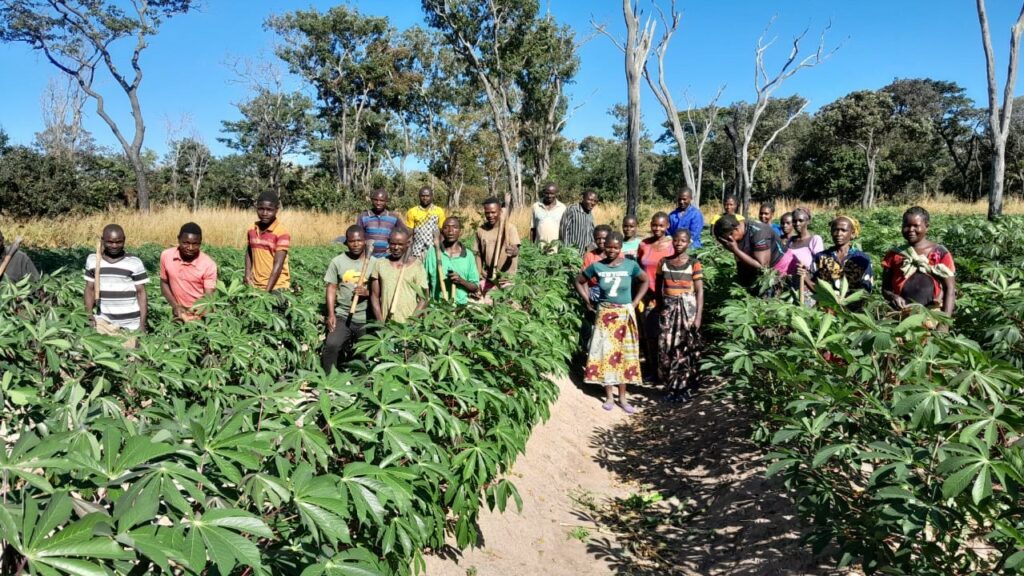Cassava brown streak disease (CBSD) was officially reported in Zambia for the first time in 2018. It is a viral disease that causes hard rots in cassava roots and can result in substantial yield losses. It gets its name from the brown streaks that form on the stem.
The typical symptoms of the disease include:
- Chlorosis on leaves, appearing as yellow patches on the green leaves of the cassava plant.
- Brown streaks on stems appear as brown lesions. These are more prominent on the green stems of younger cassava plants.
- Necrosis in the roots. These appear as hardened portions on cassava roots that are inedible to humans or animals.

CBSD affects cassava production and productivity. It hurts farmer livelihoods, households, and national food security.
A problem shared is a problem half-solved
Truer words have never been spoken. Especially concerning CABI’s ongoing campaign to raise awareness about this nationwide threat initiated in 2021. Under the PlantwisePlus programme, CABI has undertaken a multi-pronged approach to address CBSD. This approach aims to inform the nation about the occurrence, identification, and management of CBSD. CABI’s efforts in the last nine months have included the following activities…
Using radio to raise awareness of cassava brown streak disease

CABI has worked with seven local radio stations covering four provinces. Two of these provinces are currently the most affected by CBSD. The radio stations broadcast a three-week tailored program on the problem of CBSD in Zambia. The programme aired on two days for each of the three weeks. A phone-in segment was included so cassava farmers could speak directly to CABI-trained local advisors.
This gave farmers a platform to ask their questions on CBSD. The target communities greatly appreciated it.
Cassava brown streak disease on television adverts
The Zambia National Broadcasting Corporation (ZNBC), Zambia’s leading news broadcaster, aired two television adverts on curbing the spread of CBSD. Produced by CABI, they featured important national and regional influencers. The adverts, each 45 seconds in length, ran for two weeks before the main evening news at 7:00 pm. The adverts emphasized the adverse effects of CBSD and the importance of curbing the spread of the disease in Zambia.
The two adverts featured His Royal Highness Chief Kaputa of the Tabwa People and Dr. Gabriel Pollen, National Coordinator of the Disaster Management & Mitigation Unit, Office of the Vice President (DMMU-OVP). The appearances of these known personalities helped to position the messages as credible and essential in the eyes of the audience, thereby adding value to CABI’s effort.
Flyers, SMS texts, and short videos about cassava brown streak disease
PlantwisePlus produced five thousand information flyers in five languages commonly used in the CBSD-affected regions. The flyers highlighted CBSD symptoms to enable identification. Plus, farmers could use key management practices to curb the spread of the virus. These were distributed to farmers and farmer advisors in areas affected by CBSD. The languages included Silozi, Luvale, Kaonde, Bemba, and English.
PlantwisePlus programme staff sent out bulk SMS texts through their local databases. This way, farmers with mobile phones could access more information about CBSD.
CABI also developed short videos about CBSD and shared them on various social media platforms to caution the public on the harmful effects of moving cassava cuttings across provinces. Something that had become a growing practice amongst farmers…
To extend the reach of the videos, trained staff based in affected communities and extension service providers also disseminated them through their networks.
In addition, the programme is working with National Agriculture Information Service (NAIS) to disseminate the videos through their network.
Distributing disease-free cassava cuttings

In collaboration with the Disaster Management and Mitigation Unit DMMU and the Ministry of Agriculture, CABI recently undertook efforts towards training farmers and distributing disease-free cassava cuttings to 500 smallholder farmers in the Nsama District of Northern Province.
Sunbird Bioenergy Zambia in the Luapula Province provided the disease-free cassava cuttings. The Seed Control and Certification Institute (SCCI) inspected the cuttings. The plan was to distribute these cuttings to 16 farmer camps in the Nsama district.
The undertaking faced several challenges, including poor road networks, scarcity of electricity, and unreliable telecommunication services. Yet, the CABI team persisted in this endeavour. This led to the successful distribution of cuttings to 13 out of the 16 camps.

The communities expressed gratitude and are eager to use the clean cassava cuttings. This will help to mitigate the effects of CBSD.
An additional 16 lead farmers received specialized seed production training to initiate disease-free seed production in the district.
This work is essential because there is currently no cure for Cassava Brown Streak Disease. Efforts to develop disease-resistant varieties are ongoing but not at a stage where farmers may use them. In the interim, the main approaches for managing the disease include limiting the spread to disease-free provinces and introducing clean planting material into plots to mitigate the impacts for smallholder farmers.
What next for cassava farmers in Zambia?

All farmers who received the clean cuttings have since planted them in their fields. Visits will be made to the farmers to track their progress and assess the performance of the distributed cuttings. The 16 lead farmers are being monitored to ensure their production complies with national seed standards. Dissemination of information targeting various stakeholders, including farmers, extension staff, producers, processors, policymakers, and the media, continues with greater intensity towards the planting season. This is to ensure coordinated, concerted and sustainable efforts toward mitigating the spread of CBSD in Zambia.
Read more on this
Related News & Blogs
The power of street theatre – a novel approach to sharing farming know-how
Agriculture is the backbone of Pakistan’s economy. However, many farmers lack access to crucial knowledge about sustainable practices. This is especially true for women. While women form around 66% of the agricultural workforce in Pakistan, they receiv…
16 April 2025




